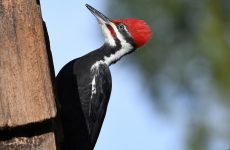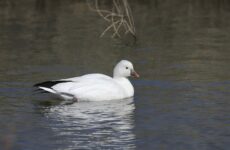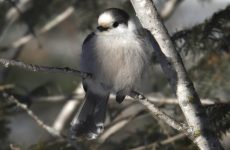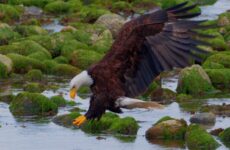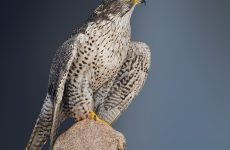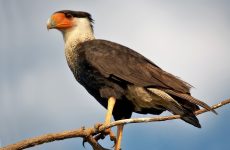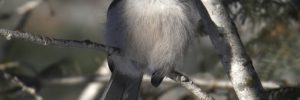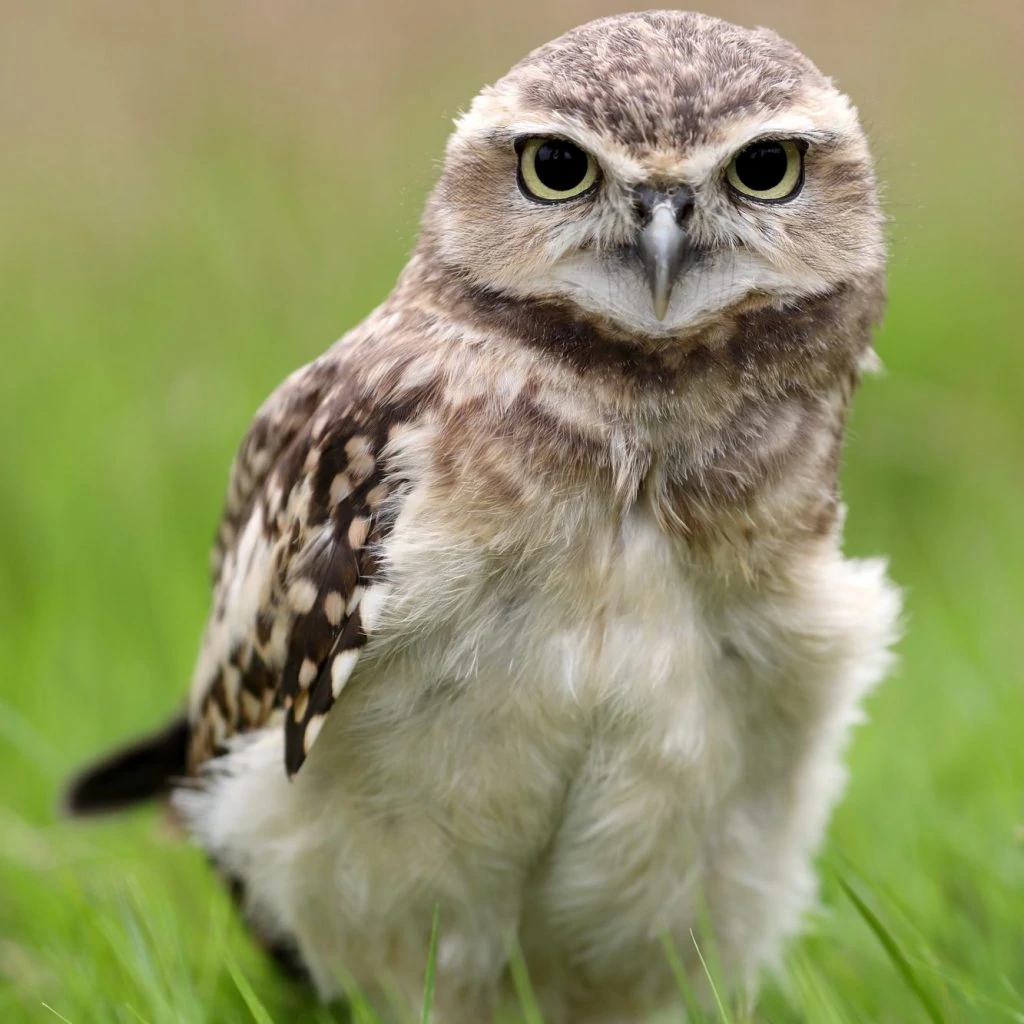
Eleven of the nineteen owls in North America are found in Minnesota. Nine of these species are regularly occurring and there are also two rare or accidental species.
These iconic birds have long held a special place in our hearts, and this guide will help you find out all about them with pictures, their hoots and calls, when to find them, and ID for each of these captivating creatures.
Owls are birds of prey and hunt and eat small mammals as well as snakes, frogs, insects and even other birds.
They eat their prey whole, often after removing the head and sometimes wings, and then regurgitate the bones and fur as a pellet.
The largest Owls in Minnesota are the Great Horned Owls, and the smallest owls are Northern Saw-whet Owls.
To find owls in Minnesota head to woodlands at dawn or dusk for the best chance of seeing them.
Try looking at high perches on the edge of the forest overlooking open grassland or pastures and listen for their calls.
Although owls look fierce, they are also pretty goofy, especially when you realize how baby owls sleep as their heads are so heavy or what owl legs look like under that fluffy coat.
Owls in Minnesota all year: Great Horned Owl, Eastern Screech-Owl
Owls in Minnesota in winter: Great Gray Owl, Snowy Owl, Northern Hawk Owl, Northern Saw-whet Owl, Short-eared Owl, Boreal Owl, Long-eared Owl
Rare or accidental owls in Minnesota: Barn Owl, Burrowing Owl
So read on to find out more about the owls of Minnesota.
11 Species Of Owl In Minnesota
1. Great Horned Owl
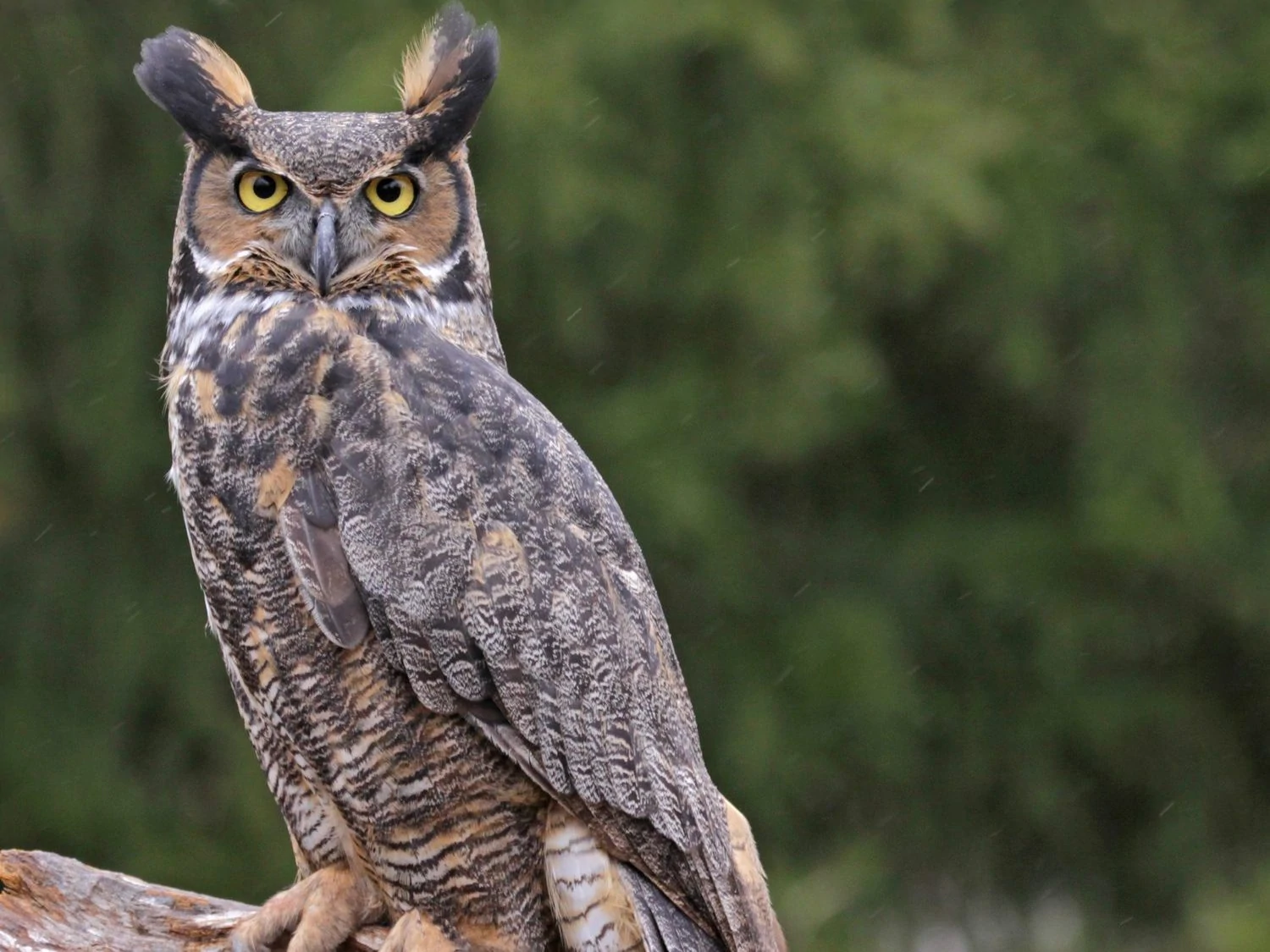
Great Horned Owls are spotted in Minnesota all year.
Great Horned Owls are one of the most common owls in North America.
Their most unique physical characteristic is their “Great Horns” which aren’t really horns but ear tufts. They’re tufts of feathers that they use as camouflage to make them appear like branches of trees.
They have grayish to reddish-brown faces, large yellow eyes outlined in black, and their hooked bills are dark gray.
The coloring and patterns of Great Horned Owls are also mainly for camouflage. Their backs and wings are mottled with gray, brown, black, or white. They can be darker or lighter depending on the region they are from and are smaller in the south than in the north.
Juveniles have white, cinnamon, or gray fluffy feathers that make them look “puffed up”. Their barring is less visible, and their ear tufts are smaller and hardly seen.
- Bubo virginianus
- Length: 18.1 – 24.8 in (46 – 63 cm)
- Weight: 32.1 – 88.2 oz (910 – 2500 g)
- Wingspan: 39.8 – 57.1 in (101 – 145 cm)
Great Horned Owls are widespread throughout North America and do not migrate.
You can find Great Horned Owls in almost any environment in North America. As long as they have nesting sites, roosting sites, and an abundance of prey, they will be able to adapt to forests, deserts, grasslands, or cities.
Their varied diet includes small rodents such as mice, skunks, geese, and hares. They will also eat insects, fish, and carrion.
Great Horned also hunt other raptors such as Ospreys, Peregrine falcons, or other owls.
They hunt from a perch, scanning their territory and swooping down to capture their prey with their strong talons. They will also hunt from the ground or wade in the water.
Great Horned Owls: The distinctive 5-note Hoo call of the Great Horned Owl is made by both males and females, but females are higher pitched. They also make various whistles, shrieks, hisses, and coos.
Nests of Great Horned Owls are usually in trees, and they often use an old nest from another species. They line the nest with bark, leaves, downy feathers, or pellets but sometimes leave it unlined. The female lays up to four eggs that are incubated for around a month.
Fun Fact: Great Horned Owls are the crows’ number one enemy. Crows will usually mob Great Horned Owls in their nests, and that is one of the best ways to find them.
2. Great Gray Owl
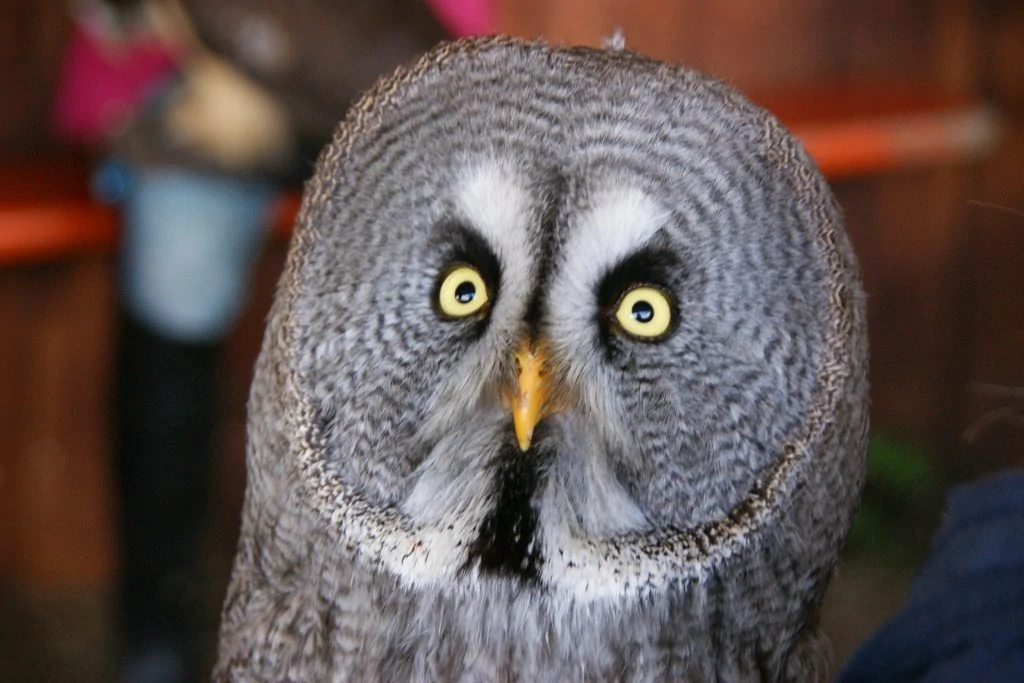
Great Gray Owls spend winter in Minnesota and are best spotted from December to February in the northeast of the state. They appear in 1% of checklists at this time.
The Great Gray Owl deserves the title of “Great” because it has a large head and has the largest facial disk among birds of prey, and a tail that’s a foot long. Its actual body may be small, but its feathers are thick and fluffy, making it look bigger than it really is.
They have long wings and tails, earning them the title “World’s Largest Owl”
Great Gray Owls are generally silvery gray with some pale gray, brown, and white streaks. They have large round heads, small yellow eyes, a hooked bill, and a white collar just under the bill. They do not have any ear tufts.
- Strix nebulosa
- Length: 24 – 33 in (61 – 84 cm)
- Weight: 27.2 oz (771 g)
- Wingspan: 54 – 60 in (137 – 152 cm)
Great Gray Owls do not migrate but may move around in some years looking for food. They are resident in Canada, Alaska, northwestern US states, and down the Pacific Coast.
You can find Great Gray Owls in dense, wet, evergreen forests. They usually hunt in open meadows with scattered trees. Bogs are also hunting grounds, and you can find them in mixed pine and oak forests.
Great Gray Owls are night hunters. First, they listen and wait at their perches. When they’ve targeted their prey, they swoop down and capture them, if in the open.
Their large facial disks give them excellent hearing that allows them to identify prey even under two feet of snow.
If their prey is under snow, they “snow-plunge” their way in to grab their prey.
Prey usually includes small mammals like voles, gophers, mice, chipmunks, and lemmings. Sometimes, they may also feast on ducks, jays, and quail.
Great Gray Owl calls: The hoo calls of the Great Gray Owl are made by males and females.
Nests of Great Gray Owls are usually in abandoned stick nests of other large birds, like hawks, ravens, or crows. They don’t build their own nests or add anything else to repair the existing nest.
Female Great Gray Owls may lay two to five eggs but may not nest at all if their food is scarce. However, when the female does lay eggs, she will incubate them for about a month, and it takes about another month for the young to leave the nest.
Fun Fact: Great Gray Owls although they look large they are actually quite small under all those feathers and so only catch small prey such as rodents.
3. Snowy Owl
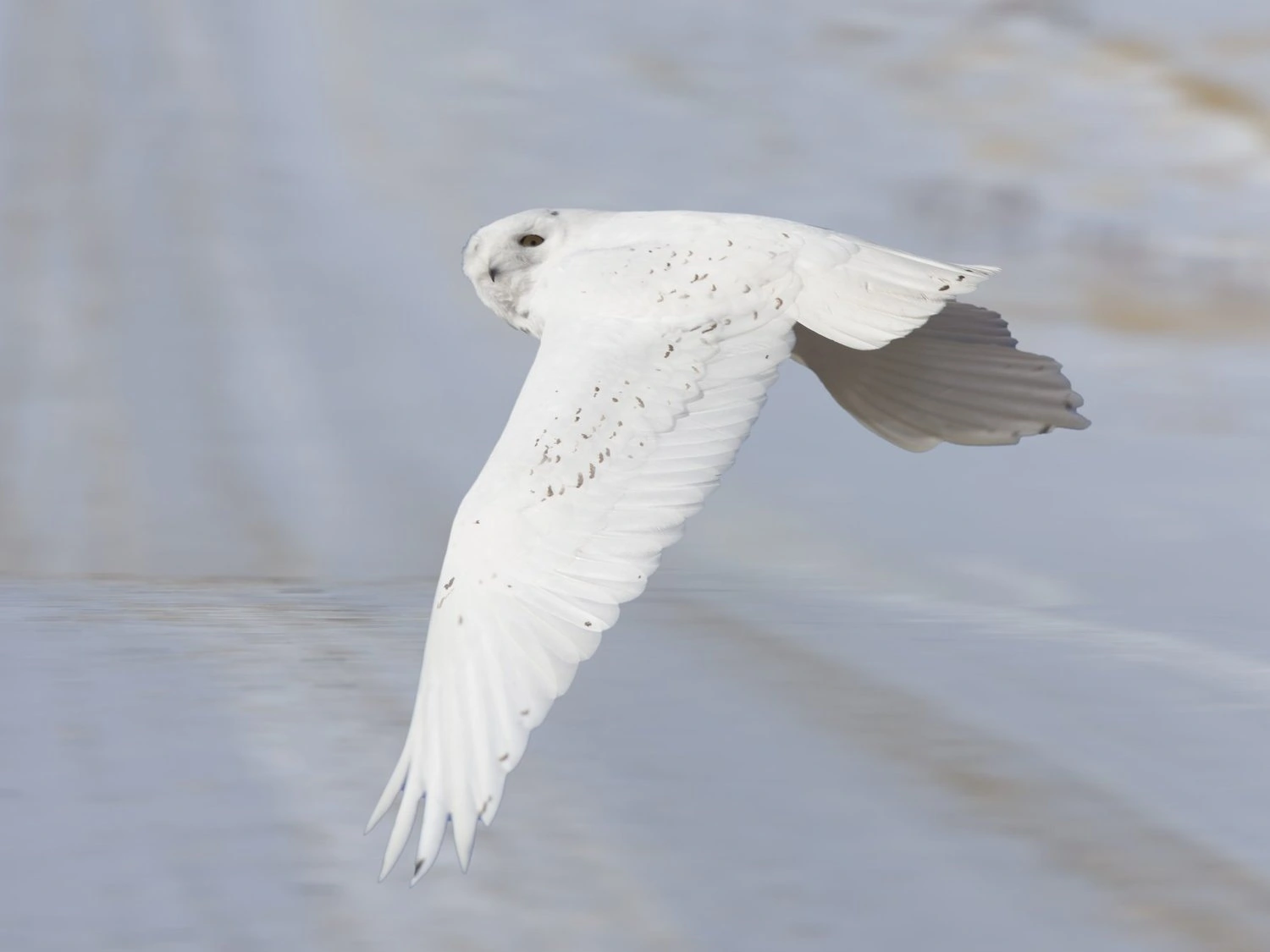
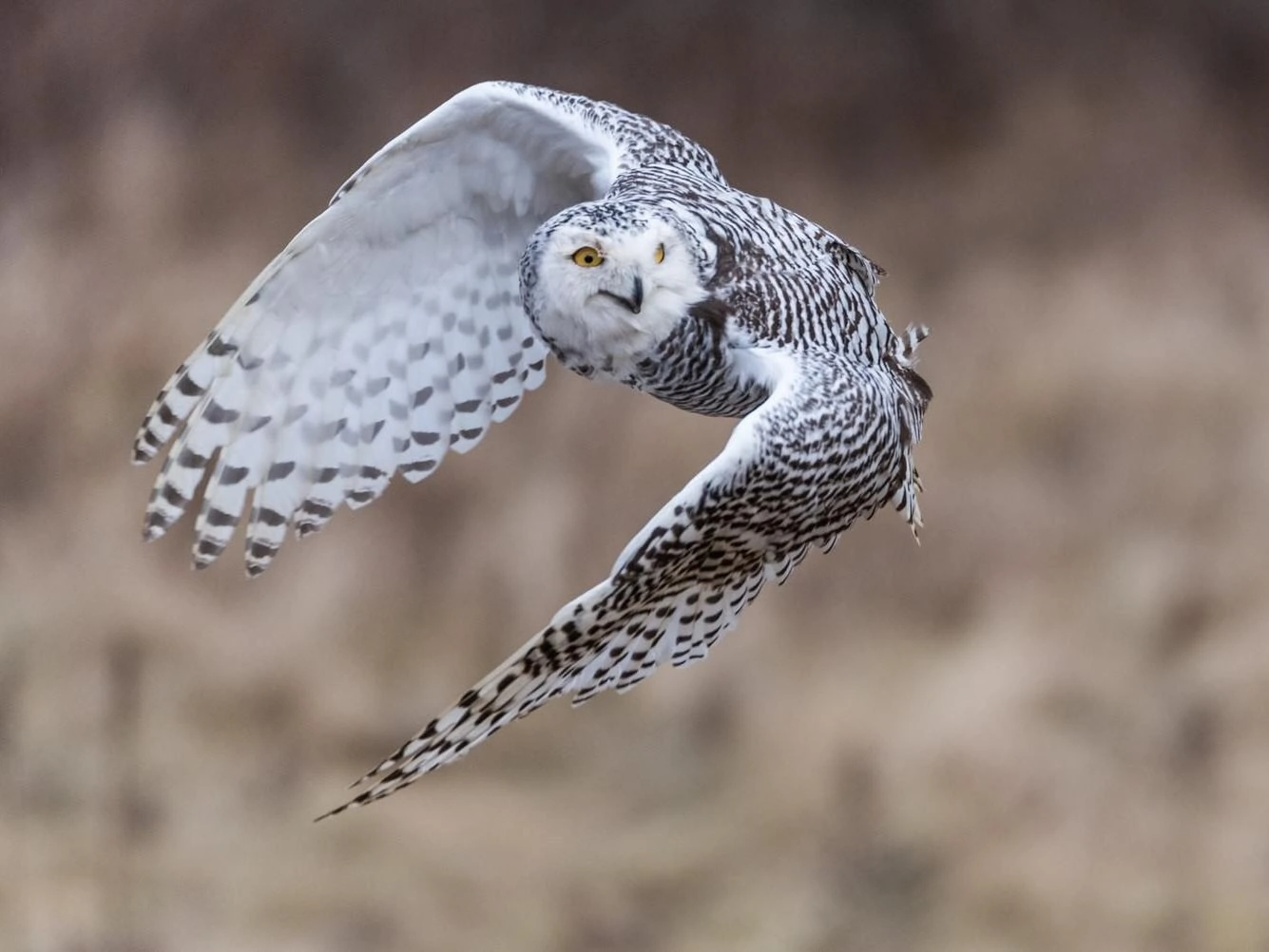
Snowy Owls are vulnerable species in Minnesota but they spend winter in the state, from October to April, and occur in 1% of winter checklists.
Male Snowy Owls are either white all over or have a small amount of brown spots.
Female Snowy Owls have flecks of dark brown to black on their backs, wings, and flanks, unlike the more white males. They also have thicker and more complete barring on their tails compared to the males.
Snowy Owls have bright yellow eyes, and their legs and feet are fully covered with feathers to protect them from the cold, harsh weather of the Arctic. They have thick dark bars on their wingtips but incomplete bars on their tails.
Juveniles have extensive brown barring all over their bodies except their faces, underwings, legs, and feet.
- Bubo scandiacus
- Length: 20.5-27.9 in (52-71 cm)
- Weight: 56.4-104.1 oz (1600-2950 g)
- Wingspan: 49.6-57.1 in (126-145 cm)
Snowy Owls breed in the arctic around the world, including the north of Canada, and migrate to southern Canada and northern US states.
You can find Snowy Owls in open Arctic tundra and prefer to situate themselves in areas with vantage points like hummocks, ridges, knolls, and bluffs so that they can keep a close watch on their surroundings.
Grassy meadows and marshes are favorite areas for hunting. However, they may move southward for the winter when prey is lacking. They may visit coastal dunes, lakeshores, prairies, and other shrubby environments that are similar to what they have in the Arctic.
Snowy Owls are diurnal, unlike most other owls, and spend the 24-hour summer daylight hunting in the arctic.
They hunt small mammals, especially lemmings, and can eat 1600 in a year.
They also catch birds in flight, such as ptarmigan or waterfowl. In winter, they will eat rodents, rabbits, squirrels, and birds such as ducks and geese.
Snowy Owls calls: They make a strong raspy Hoo sound. They also hoot, whistle, and hiss if threatened.
Nests of Snowy Owls are just scraped, shallow hollows in the ground on one of the raised areas of the tundra. They pick a windswept rise that will be blown free of snow and reuse the nest for many years.
The nests themselves have no insulating materials. The female lays three to eleven eggs at 2-day intervals. Incubation begins as soon as the first egg is laid. Both parents feed the chicks, with the female turning their food into bite-sized pieces.
Fun Fact: The Snowy Owl is also known as the Arctic Owl, the Polar Owl, and the White Owl.
4. Northern Hawk Owl
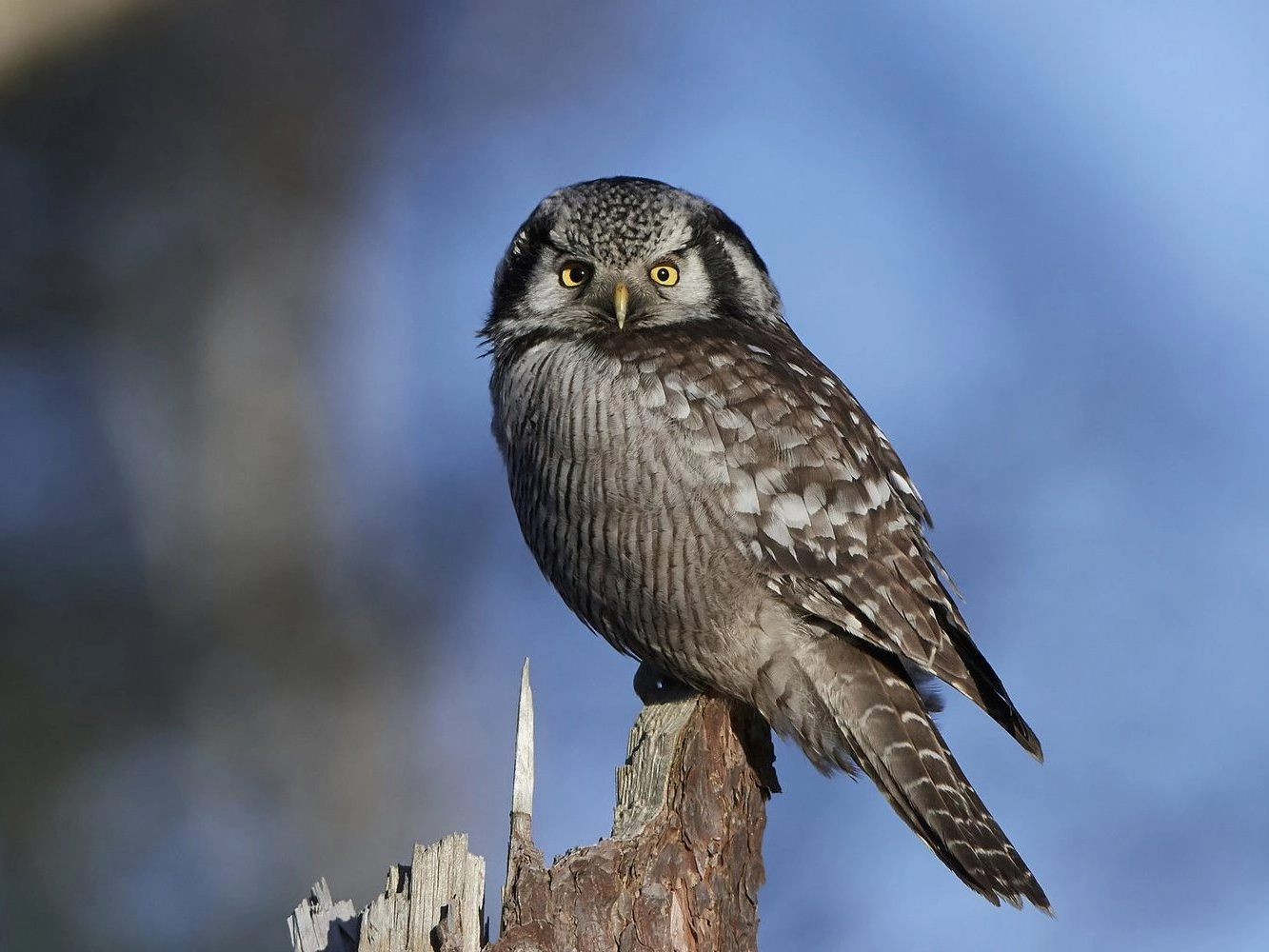
Northern Hawk Owls are spotted in the north of Minnesota during winter from October to April and are recorded in 1% of checklists at this time.
Northern Hawk Owls have white faces that are outlined by thick black lines, and their eyes and bills are yellow. Their backs and wings are brown with white spots.
Their breasts and bellies are white with horizontal brown stripes, and their tails are long and brown with white horizontal lines. Their legs and feet are fully feathered.
Juveniles have the same features, except that they’re paler and fluffier.
- Surnia ulula
- Length: 14.5 – 17.5 in (37 – 44 cm)
- Weight: 10.5 oz (298 g)
- Wingspan: 33 in (84 cm)
Northern Hawk Owls do not migrate and are mainly resident in the cold north in Canada and Alaska.
You can find Northern Hawk Owls in open pine and spruce forests or those mixed with larch, birch, poplar, and willow. They also favor burned areas of forests because these are good nesting sites.
Northern Hawk Owls primarily feed on mammals, particularly voles, during the summer. During the winter, they shift their diet to eating ground-dwelling birds, like ptarmigan and grouse.
Unlike most owls, Northern Hawk Owls are day hunters
Northern Hawk Owls calls:
Nests of Northern Hawk Owls are usually on broken, open tree stumps or in abandoned woodpecker holes or decayed hollows. Both parents scout their nesting area and prefer locations in open forests with scattered trees, usually near the water.
The female lays up to thirteen eggs and incubates them for about a month while the male looks for food to feed her. Once the eggs hatch, parenting roles shift.
The female is then the one who hunts, and the male tends to the nest. When the young leave the nest, the female once again takes over tending duties, but the male will still be around to provide food for his family.
Fun Fact: Northern Hawk Owls have ‘hawk’ in their name because they look hawk-like and hunt in the day.
5. Eastern Screech-Owl
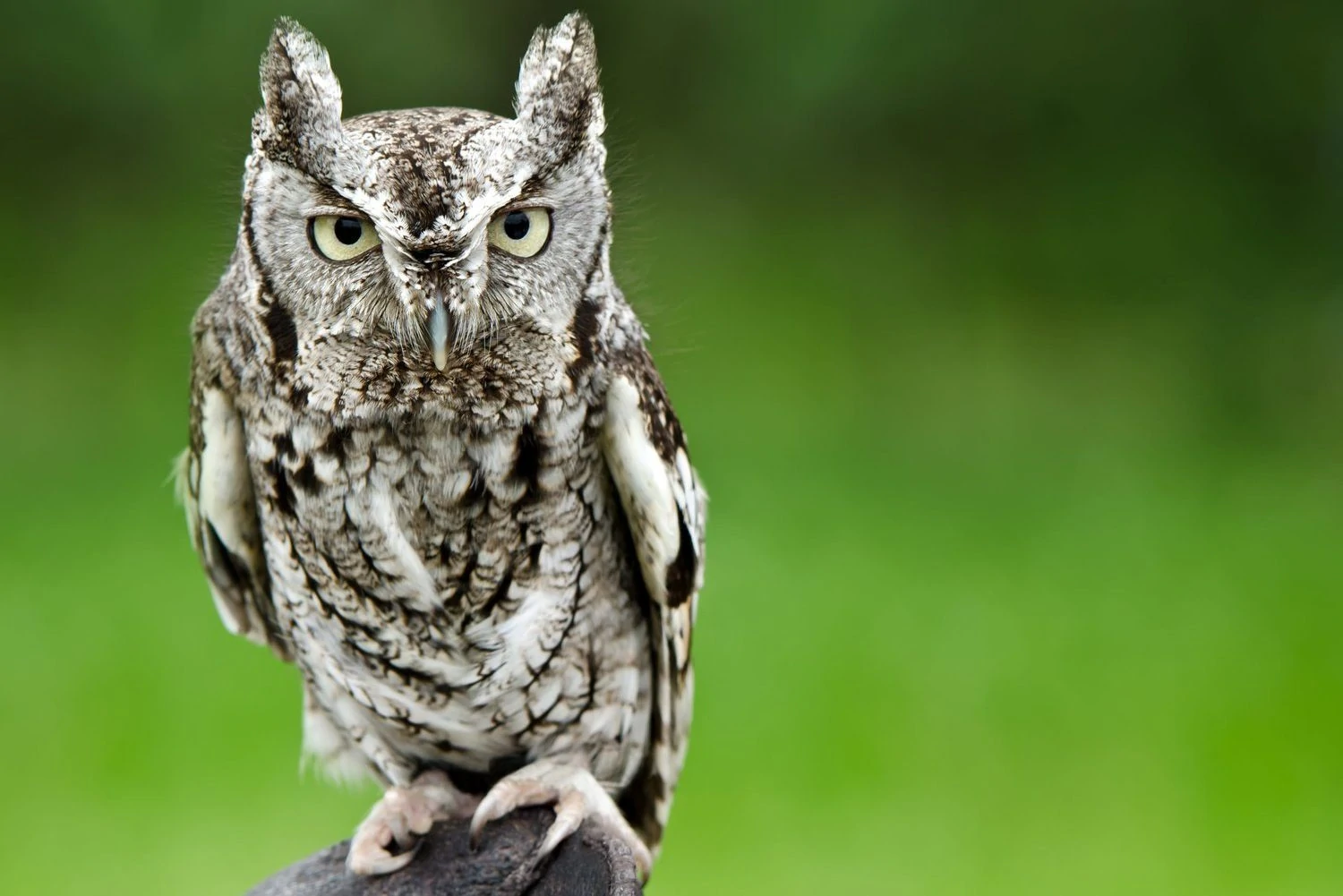
Eastern Screech-Owls do not migrate and are spotted in Minnesota all year, mainly in the south of the state.
Eastern Screech Owls are short, stocky birds with mottled coloring, and they are either more red or gray depending on location. They have a large head and almost no neck. Their patterned and spotted camouflage makes them hard to spot against tree bark.
They are only about the size of a robin but much bulkier.
- Megascops asio
- Length: 6.3 – 9.8 in (16 – 25 cm)
- Weight: 4.3 – 8.6 oz (121 – 244 g)
- Wingspan: 18.9 – 24.0 in (48 – 61 cm)
Eastern Screech-Owls do not migrate and, as their name suggests, are resident in the eastern half of the US.
You can find Eastern Screech-Owls in woods and parks, and you may find one sunning itself in a tree cavity on cold sunny days or by the excited mobbing of songbirds when they find them. A pile of pellets is also a giveaway.
Eastern Screech-Owls hunt mostly at night but also at dawn and dusk. They hunt for small animals, including birds, mammals, insects, reptiles, and amphibians. They often sit and wait for prey to pass and then pounce from their perches.
Eastern Screech-Owls calls: They have a range of calls, hoots, screeches, and whistles. The common ones are a shrill descending whinny and a constant bouncing call which is known as a tremolo.
Nests of Eastern Screech-Owls are often in abandoned woodpecker nests as they never dig one themselves. They don’t add any nesting material, and instead, they lay their eggs on whatever debris is on the bottom of the cavity. They lay two to six white eggs.
Fun Fact: Young Screech Owls may fight to the death in the nest, often over food. This is known as siblicide.
6. Northern Saw-whet Owl
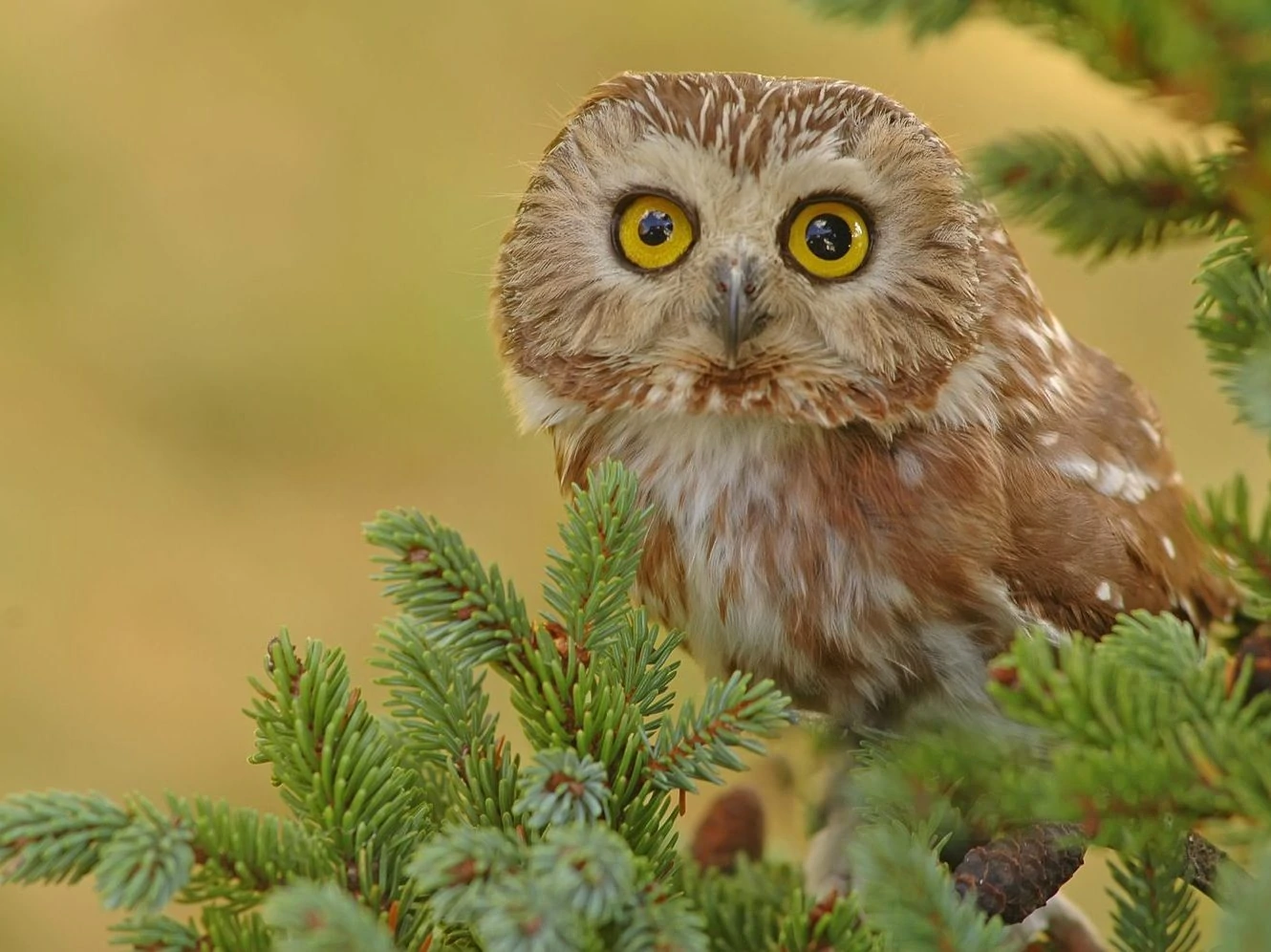
Northern Saw-whet Owls are spotted in the north of Minnesota during the breeding season and some also hang around all year in the northeast of the state. However, they spend winter across the rest of the state.
Northern Saw-whet Owls are one of the smallest owls in North America, with them being about the size of a robin.
They have tiny brown bodies but large round heads with fine white streaks. Their eyes are bright yellow with thick white feathers forming a “Y” in between them.
Their backs and wings are brown with white spots. Their chests and bellies are white with brown streaks.
Juveniles have plain brown heads and very visible white eyebrows on brown facial discs. Their underparts are plain cinnamon brown, and they also have no spots on their backs.
- Aegolius acadicus
- Length: 7.1 – 8.3 in (18 – 21 cm)
- Weight: 2.3 – 5.3 oz (65 – 151 g)
- Wingspan: 16.5 – 18.9 in (42 – 48 cm)
Northern Saw-whet Owls are usually resident all year in Canada, northern US states, and western US states. However, they may migrate to lower areas in winter to the rest of the US.
You can find Northern Saw-whet Owls in dense coniferous forests where they roost hidden among the thick branches and foliage. However, they like it near an open area and water source where they hunt.
They are nocturnal, so they hunt mostly mice from a perch at night. They may also eat voles, bats, chipmunks, and squirrels.
Northern Saw-whet Owls calls: A long series of urgent hoo calls.
Nests of Northern Saw-whet Owls are tree cavities that have been left from other species, such as Pileated Woodpeckers. They do not add any other nesting material and instead lay their eggs directly on the debris.
The female lays four to seven eggs that take four weeks to incubate. The male’s job is to bring the female food while she’s incubating.
Attracting Northern Saw-whet Owls to your backyard is possible with a nest box if you are in range and have lots of trees.
Fun Fact: The Northern Saw-whet Owl got its name from its repeated tooting whistle, or the “skiew” sound that it makes when it’s alarmed or threatened. The sound is similar to the whetting of a saw.
7. Short-eared Owl
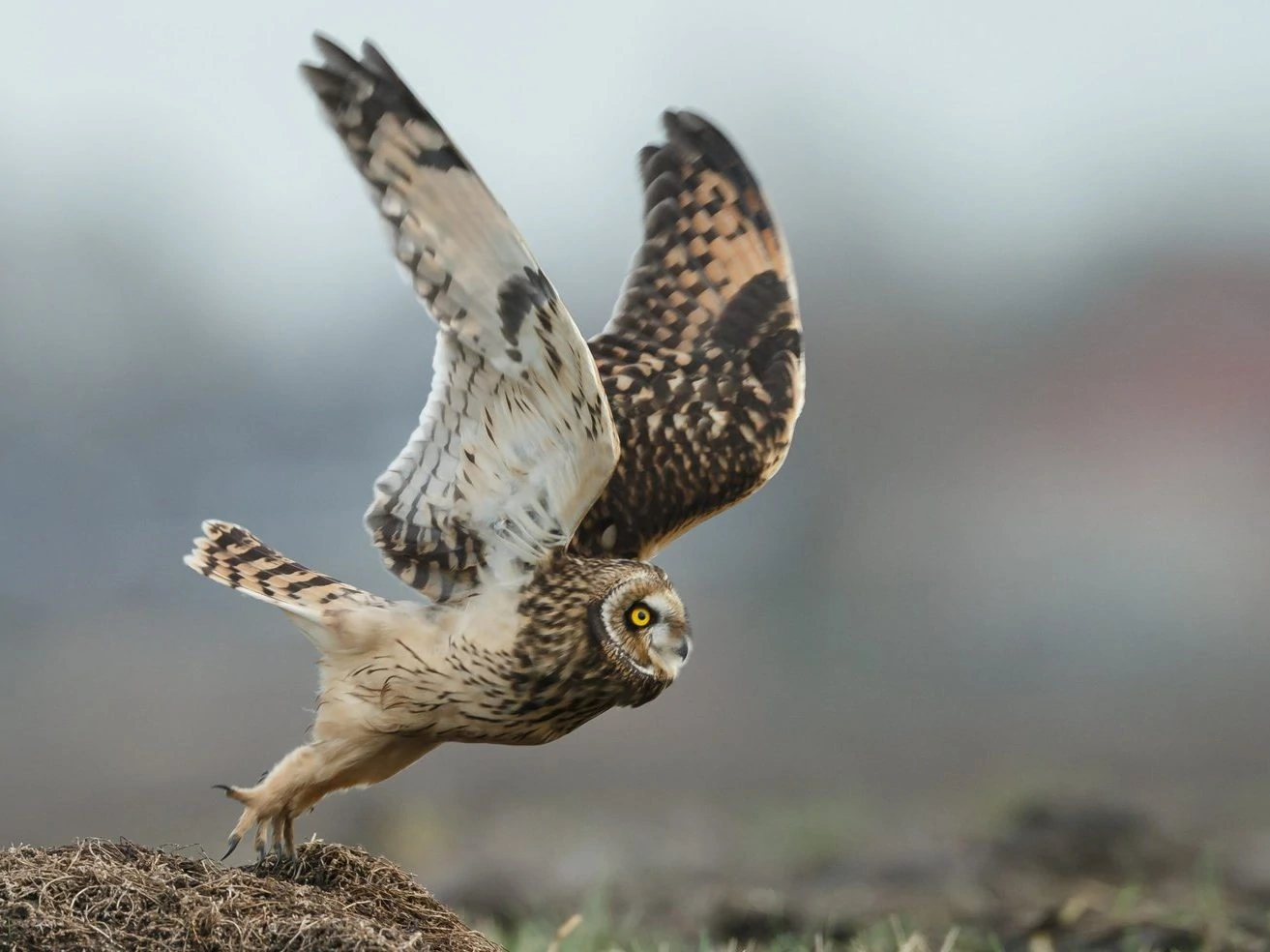
Short-eared Owls are spotted in Minnesota during winter, mainly in the west and south of the state.
Short-eared Owls are aptly named because they do have short ear tufts, hardly visible except when in a defensive pose.
They are medium-sized, with a large, round, pale facial disk bordered in white. Their eyes are yellow and outlined in black. Their bills are short, hooked, and black.
Their backs and wings are light and dark brown and white mottling. The upper breast is heavily streaked with dark brown, but the chests and bellies are pale or buffy. Their tails are also barred with dark brown.
- Asio flammeus
- Length: 13.4 – 16.9 in (34 – 43 cm)
- Weight: 7.3 – 16.8 oz (206 – 475 g)
- Wingspan: 33.5 – 40.5 in (85 – 103 cm)
Short-eared owls that breed in Canada and Alaska usually migrate to the US for winter, but many remain all year in northern US states.
You can find Short-eared Owls everywhere in the world except for Antarctica and Australia. They particularly like uninhabited areas since they nest and roost on the ground, such as open prairies, coastal grasslands, tundra, marshes, and dunes.
Unlike most owls, Short-eared Owls hunt during the day, mostly at dawn and dusk, timing their hunt when voles are especially active.
They fly low over the ground looking and listening for movement from their prey of small mammals such as voles and mice.
They also eat birds like gulls and shorebirds, and usually take off the wings of the birds before they eat them.
Short-eared Owls calls: They are relatively quiet, but they make a series of continuous hoots and also scream, bark and whine.
Nests of Short-eared Owls are built by scraping the ground into a bowl and lining it with grass and soft feathers. They are usually concealed among tall grasses and low plants, and the female lays four to seven eggs but may lay more if their prey is abundant. Incubation is around four to five weeks.
Fun Fact: Short-eared owls are not very vocal, but during courtship, the males will make about a dozen hoots, and they may bark, whine or scream when defending the nest.
8. Boreal Owl
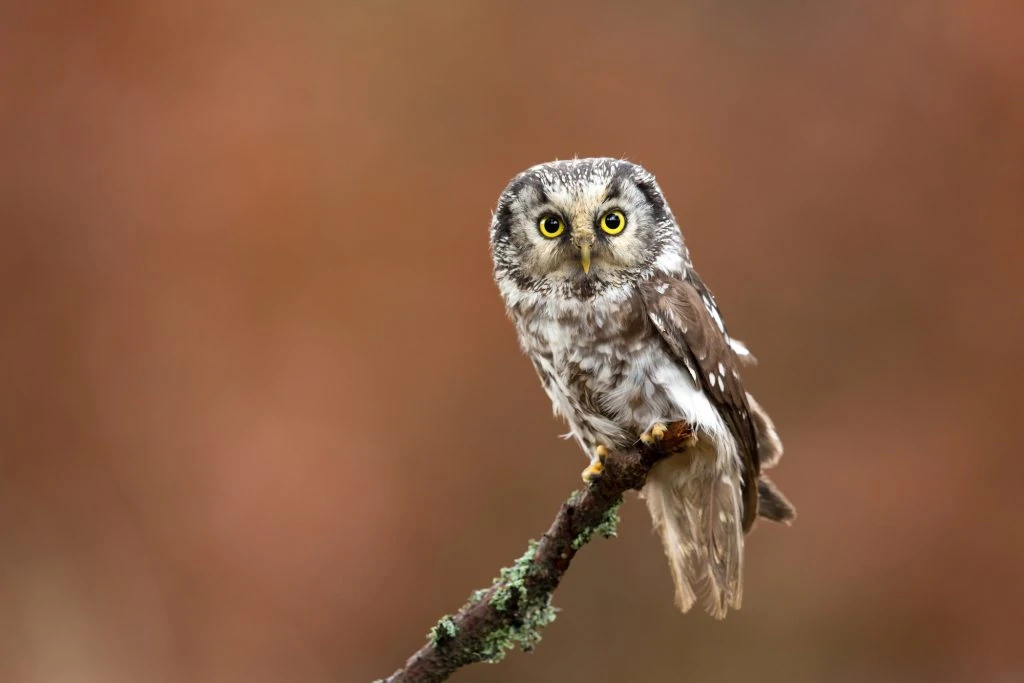
Boreal Owls are not very common in Minnesota but they are spotted here during winter, from November to April.
The Boreal Owl is a rather small owl with a large square head.
Adult Boreal Owls are generally brown. They have white spots on their heads and back. Their faces are grayish or whitish, bordered by black or brown.
They have bright, yellow eyes and light yellow beaks. Their bellies are white but with vertical, brown streaking.
Adults look similar, but females are heavier. Juveniles are chocolate brown, and they don’t have white spots on the crown and back.
- Aegolius funereus
- Length: 9 – 10 in (23 – 25 cm)
- Weight: 3.6 oz (102 g)
- Wingspan: 20 – 26 in (51 – 66 cm)
Boreal Owls do not migrate and predominantly live in Canada and northwestern US states.
You can find Boreal Owls, as their name suggests, in the boreal or northern coniferous forests of North America.
They normally live in forests or high-elevation mountains with spruce, aspen, poplar, birch, and fir trees.
Boreal Owls are night-hunters, but in some areas, like those where nights are short, they have no choice but to hunt in daylight.
They hunt small mammals, birds, and insects, waiting from their perches and attacking them with their talons. They normally feed on voles, mice, shrews, bats, frogs, and squirrels.
Boreal Owl Calls: Male Boreal Owls sing a series of whistled toots. They also make short calls.
Nests of Boreal Owls are made by males, and then females choose from among the nest sites that he shows her. These nests are often old woodpeckers’ holes.
The female lays three to seven eggs and starts incubating them after the 2nd egg is laid for around a month. The male brings food to the female all throughout the nesting period.
Attracting Boreal Owls to your backyard is possible with nest boxes as will often use them in the absence of natural cavities in trees.
Fun Fact: One ear opening of Boreal Owls is much higher than the other to help them judge the distance and height of sound to find prey.
9. Long-eared Owl
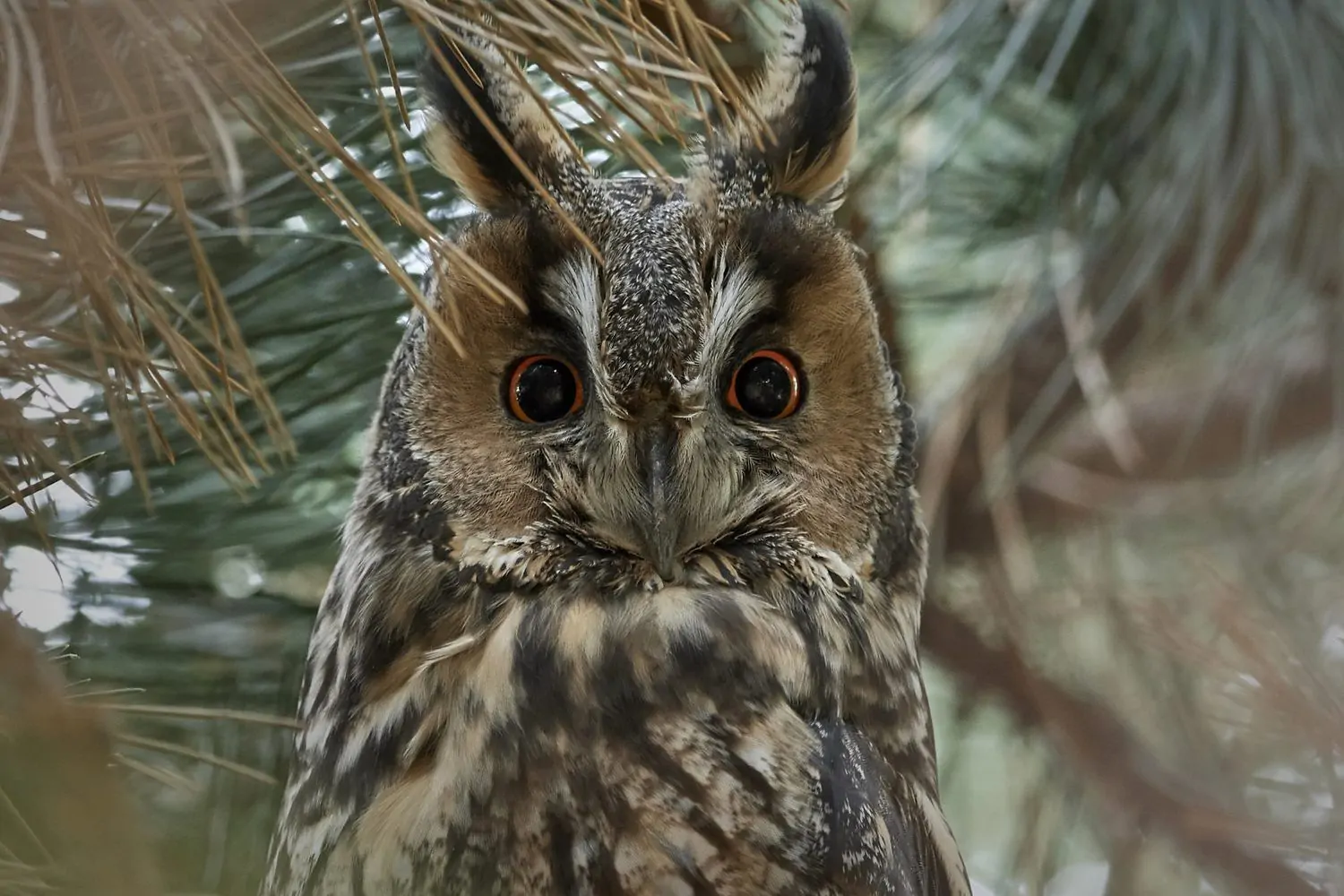
Long-eared Owls breed in the northwest of Minnesota but they are also spotted migrating south for winter.
Long-eared Owls are slender, medium-sized owls known for their obvious ear tufts, hence their name. They look similar to Great Horned Owls but are much smaller, and the ear tufts are closer together.
They have a surprised expression due to their facial disc and mustache-like feathers around their bill.
Their upperparts are mottled gray, brown, white, and buff. Their underparts have a unique cross-barred pattern of varying orange, brown, black, and white. Their tails are white with dark brown barring.
They are darker in eastern US states and lighter in the west.
- Asio otus
- Length: 13.8 – 15.8 in (35 – 40 cm)
- Weight: 7.8 – 15.3 oz (220 – 435 g)
- Wingspan: 35.4 – 39.4 in (90 – 100 cm)
Long-eared Owls breed in Canada and northern US states and migrate to the rest of the US and Mexico for winter. However, some remain resident all year, especially in inland western US states.
You can find Long-eared Owls in wooded areas with dense coniferous or deciduous trees for roosting and near open grasslands for hunting. The thick foliage of these trees helps camouflage them from potential predators.
Small mammals such as voles, mice, young rats, and rabbits are the main prey of Long-eared Owls, but they may also eat small birds
They fly just a few feet off the ground, listening for movement of prey.
Long-eared Owls calls: They are relatively silent owls but make slow, steady ‘whoo’ calls during the breeding season.
Nests of Long-eared Owls are often stick nests abandoned by other species, or they use tree cavities or hollows.
The female lays up to ten eggs and incubates them for about four weeks. It takes around three weeks for the chicks to start “branching” out even though their parents will still feed them at this point.
Fun Fact: Long-eared Owls are rarely heard except during breeding time. They make soft low hoots and whistles, whines, shrieks, and cat-like meows.
10. Barn Owl
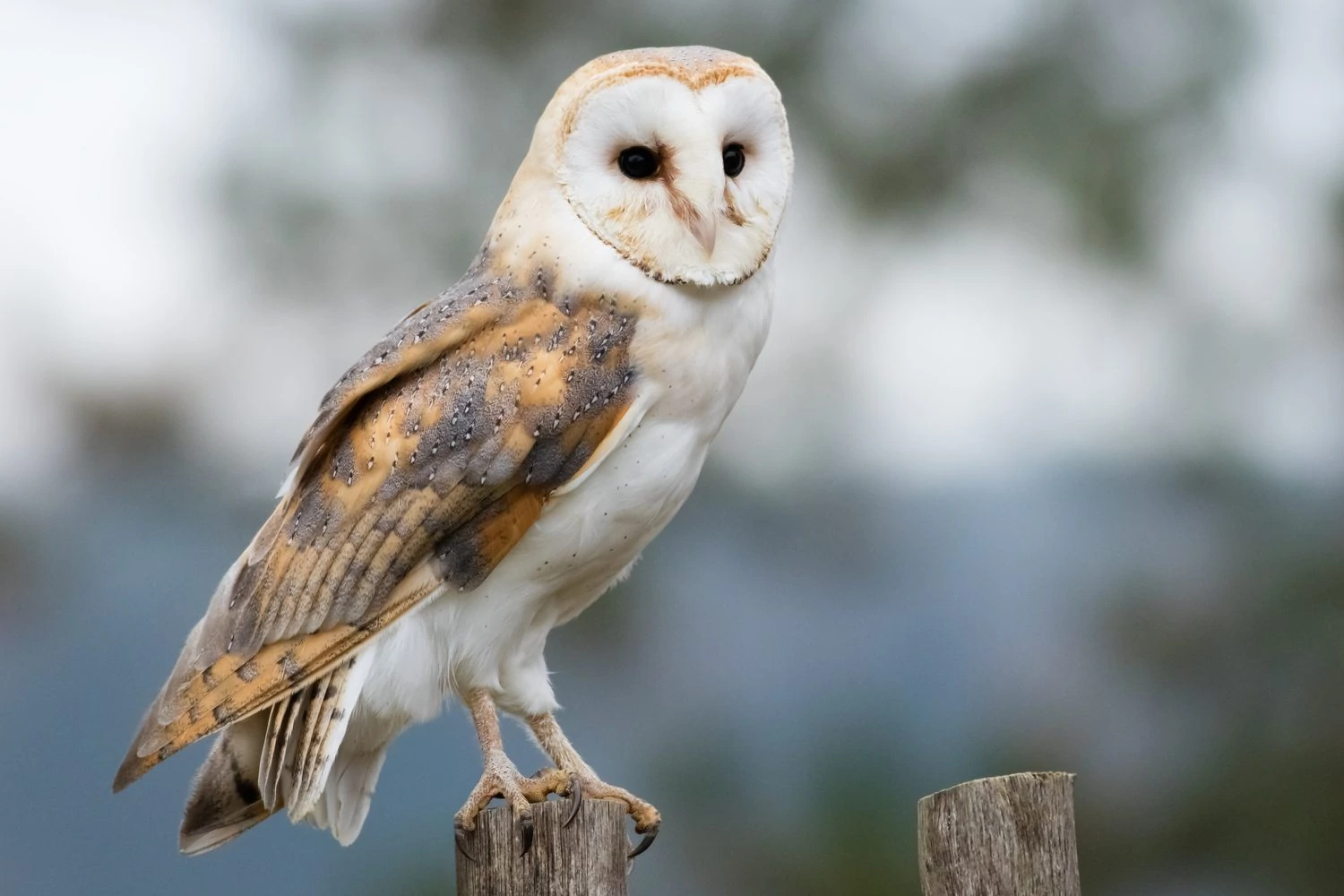
Barn Owls are extremely rare in Minnesota and are considered accidental species in the state. They were last spotted around Wabasha in 2021.
Barn Owls are the most widespread land birds in the world, with as many as thirty-five subspecies and they are found on all continents except Antarctica and the Saharan desert.
Barn Owls’ white heart-shaped faces and contrasting dark eyes make them one of the most beloved owls.
Their chests, bellies, and underwings are also white with varying amounts of spots. Their upperparts are a combination of gray, brown, and red colors, with some being lighter or darker than others. They have long rounded wings, short tails, and long legs.
- Tyto furcata
- Length: 12.6 – 15.8 in (32 – 40 cm)
- Weight: 14.1 – 24.7 oz (400 – 700 g)
- Wingspan: 39.4 – 49.2 in (100 – 125 cm)
Barn Owls do not migrate and can be found in most US states and just across the northwestern border into Canada.
You can find Barn Owls in largely open habitats, edges of forests, agricultural fields and farmlands, suburbs, and cities.
During the day, make sure to look in hollow logs and cavities in trees and in barns (hence their name) where they roost.
Barn Owls predominantly find prey by sound as they have the best hearing of any animal tested. This helps them to catch prey in complete darkness or those hidden under vegetation or snow.
Their usual prey includes small mammals like rats, voles, bats, rabbits, and lemmings. They will also hunt and kill small birds, lizards, and insects.
They swallow their prey whole and cough up pellets containing bones and fur twice a day.
Barn Owl Calls: They don’t hoot, but make a harsh screech.
Nests of Barn Owls are usually in tree cavities or caves and often in barns or other abandoned or quiet buildings. They lay up to eighteen white eggs and up to three broods. The incubation takes around a month.
The nest is made of regurgitated pellets arranged into a cup with their feet.
Fun Facts: Females have spots on their chests that have been shown to reduce parasites, and so the more spots the female has, the more a male helps build the nest!
11. Burrowing Owl
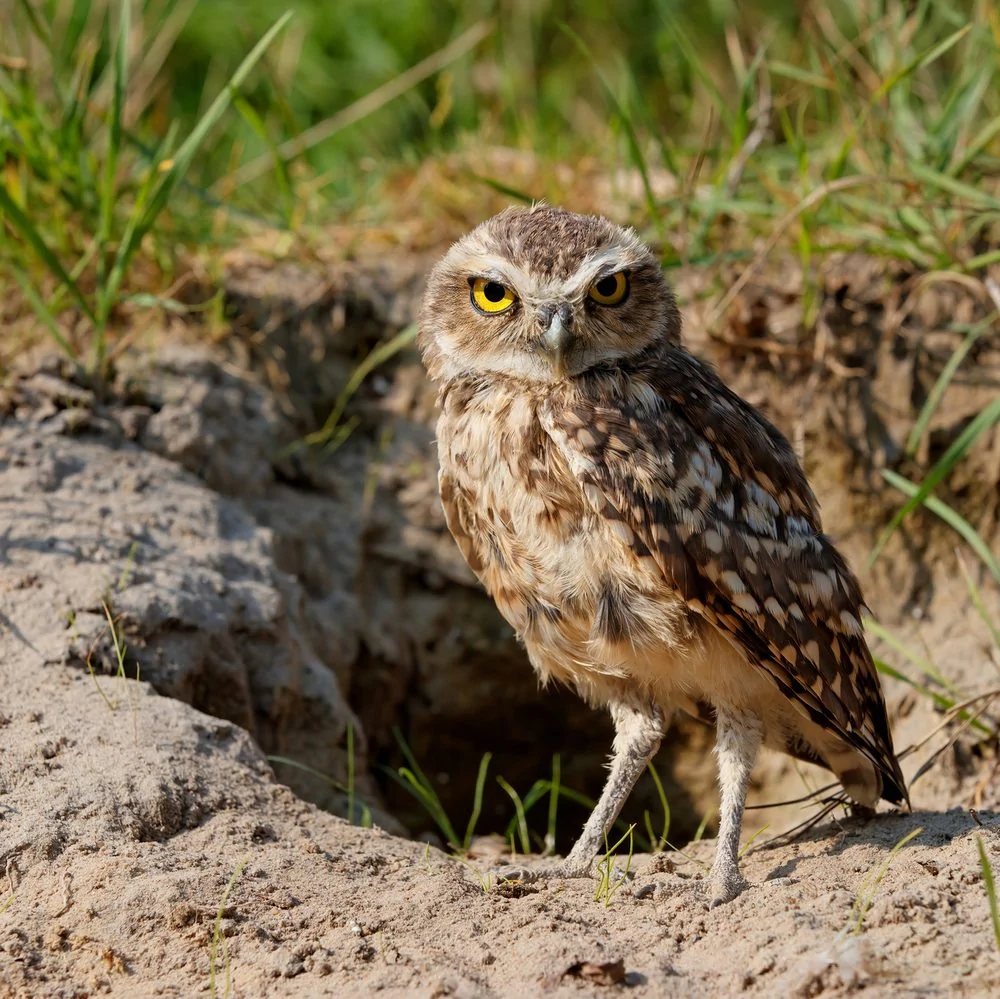
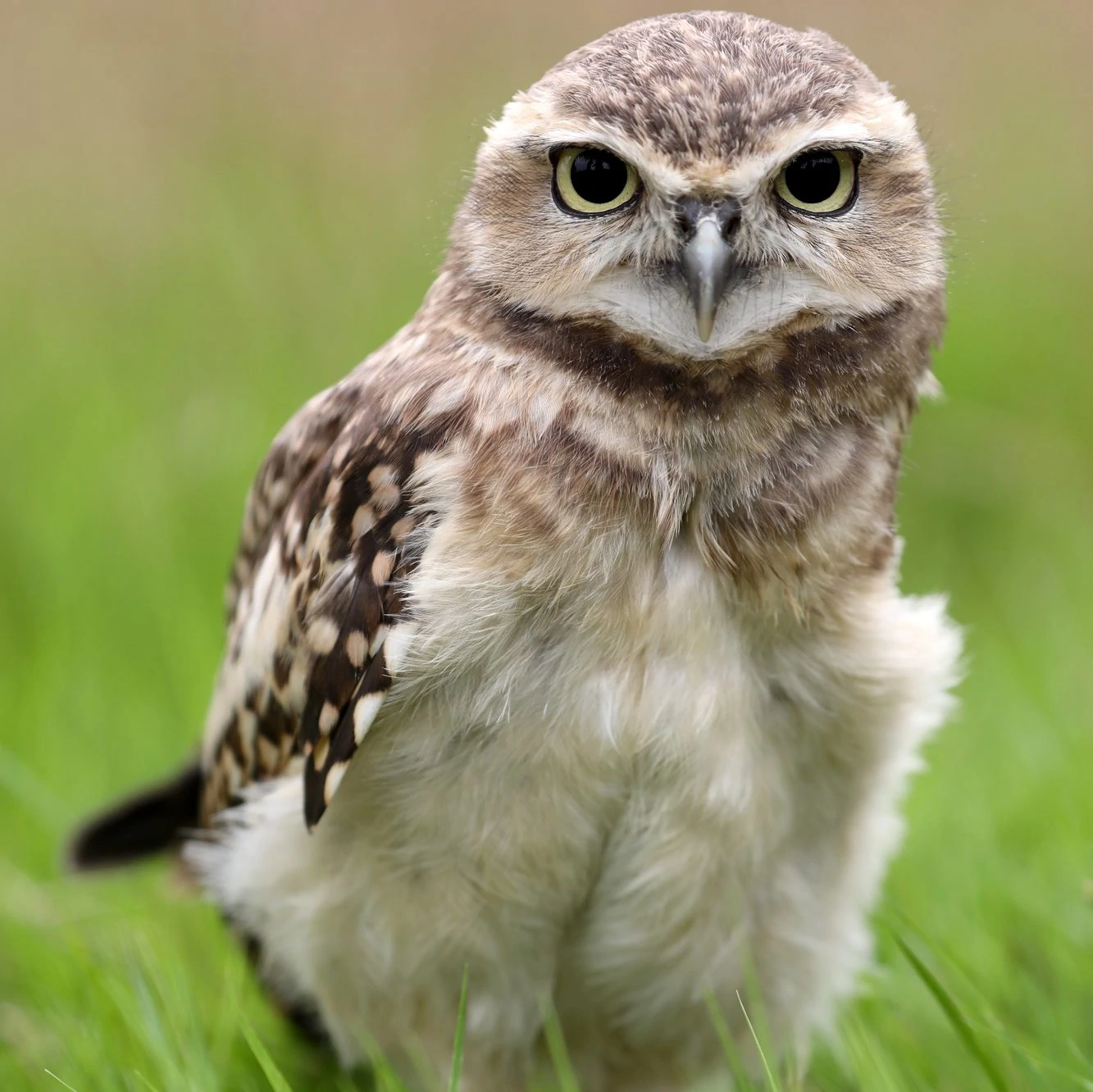
Burrowing Owls are accidental species in Minnesota. They are extremely rare in the state and were last spotted around Moorhead in 2008.
Burrowing Owls are small, long-legged owls that typically lives in prairie dog burrows (hence its name).
Adult Burrowing Owls generally have brown feathers with numerous white spots and no ear tufts.
They have yellow eyes and bills and a white patch on their chins which becomes visible when they bob their heads or when they become agitated.
Juveniles are also generally brown, they have no white spots on their heads, and they have plain white bellies.
- Athene cunicularia
- Length: 9 – 11 in (23 – 28 cm)
- Weight: 5.3 oz (150 g)
- Wingspan: 20 – 24 in (51 – 61 cm)
Burrowing Owls breed in western US states and migrate south to Mexico for winter. Those in southwestern US states and Florida remain all year.
You can find Burrowing Owls in deserts and open grasslands, prairies, and agricultural areas. Rather than looking for them in trees, look for them hunting on the ground, nesting in underground dens, and perching on fence posts.
Burrowing owls hunt both day and night.
They rest in their burrows in between hunting. They sit and wait from their perch and then silently glide to their prey. They catch mice, small rabbits, rats, gophers, bats, lizards, and small birds.
They can run and fly low when hunting on land, but they can also wade through shallow water to catch other animals.
Burrowing Owls calls: They are relatively quiet owls. Males make a coo call, and the young are able to mimic a rattlesnake rasp.
Nests of Burrowing Owls are old, underground holes dug by prairie dogs, badgers, and other burrowing animals. Florida Burrowing Owls dig their own burrows, and Cape Coral has at least 1,000 nesting pairs. They may also use old pipes or nest boxes.
The female lays seven to twelve eggs which she incubates for three to four weeks. The male supports her by bringing food. When the eggs hatch, both parents feed their young and will continue to do so until they’re about three months.
Fun Fact: Burrowing Owls use animal dung or manure to attract insects to the burrow and control the microclimate! The dung or manure that is often used in nest building was originally thought to mask the scent of juvenile owls.

